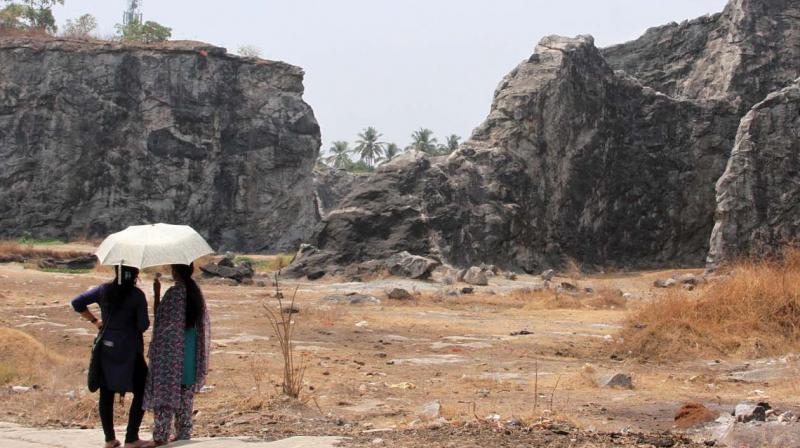Beware, drought looms large
The severity of drought will vary from place to place depending upon the hydro- geology.

Kerala has not received good northeast monsoon rains and summer rains (till now), and hence, there is a high possibility for drought condition across the state. The severity of drought will vary from place to place depending upon the hydro- geology.
After the recent floods, some parts of Kerala witnessed faster depletion of groundwater and also lowering of water table in rivers. During non-monsoon season, active soil water storage releases water to rivers. Removal of fine topsoil, formation of greater soil pipes, massive loss of stored soil waters due to landslides and extensive destruction of riparian and riverine vegetation is fast depleting this active soil water storage that normally helps tide over the rainless periods after the monsoons.
Rainfall Analysis
A study was carried out at Centre for Water Resources Development and Management Kozhikode to analyse meteorological drought and drought severity in Kozhikode district by analysing last 116 years data (1902 to 2018).
Kerala experienced extreme precipitation events during the 2018 southwest monsoon period with multiple episodes culminating in devastating floods across the state during August 14-18 (41 per cent excess during June 1 to Aug 22) and over all, this year, the rainfall was 23.34 per cent more than the normal rainfall (IMD 2018). However the northeast monsoon showed a departure of – 3.34 per cent for the state as a whole.
Similarly winter rainfall (Jan and Feb 2019) showed a deficit of -46 per cent of rainfall than the normal. In this Kasargod district experienced a deficit of -19.35 per cent during SW monsoon, -38.37 per cent during NE monsoon and - 100 per cent during winter season respectively.
The rainfall trend in 116 years showed a decline in annual as well as southwest monsoon rainfall and this will have a larger impact on productivity of many perennial crops.
Temperature analysis showed that the maximum temperature shows a significant increasing trend and minimum temperature shows a significant declining trend with a significance level of 5 per cent in seasonal as well as annual scale.
During first week of March, Kozhikode observed highest maximum temperature with an anomaly of 3.90 C over the normal 2 temperature and IMD predicted the heat wave in some parts of Kerala. However, CWRDM data and also IMD data of Karipur airport showed a departure of -1.9 to 2.50 C.
Maximum temperature was above normal in Alappuzha, Kozhikode and Thiruvananthapur-am districts and remained normal elsewhere.
Another study conducted by CWRDM evaluated the various drought indices for the humid, semiarid and arid regions of India using conventional indices, such as rainfall anomaly index, departure analysis of rainfall and other indices such as Standard Precipitation Index (SPI) and Reconnaissance Drought Index (RDI) and found that RDI was found to be an effective tool to understand the drought.
Humid region showed a decreasing trend in initial value of RDI during the drought as compared to semiarid and arid regions and indicated possible climate change impact in these regions.
In humid tropic regions, the humidity started to decrease towards the recent years, while for other two categories the slope showed small increment towards humidity. This showed the possible indication of a climatic change in the humid regions, where the maximum temperature increase was also witnessed with a reduction in rainfall during some seasons.
What is drought?
Drought is a natural recurring feature of climate and occurs virtually in all climatic regions. The concept to define drought varies with the subject of interest- meteorological, hydrological and agricultural droughts.
A meteorological drought refers to the deficiency of rainfall, hydrological drought refers to lack of available water in fresh water bodies or to maintain the ecosystem flows and agricultural drought refers to the deficit in soil moisture to sustain crops and livestock, but ultimately all these leads to socio-economic drought.
Drought is different from other natural hazards owing to the lack of a universal common definition. It must be defined according to characteristics of each climatic regime and specific impact sector.
Drought may be considered as the shortfall / deficiency of available water severely, affecting the potential production of crops, runoff requirement of surface water bodies (stream flow), recharging of groundwater and reduction in environmental / ecosystem flows.
It causes scarcity of water for human/livestock consumption and influences the entire renewable economic resources, finally resulting in a disaster for the entire mankind.
(Contributed by Dr U. Surendran, Dr K Madhava Chandran and Dr A.B. Anitha, Centre for Water Resources Development and Management, Kozhikode)

